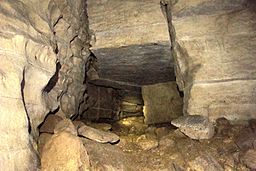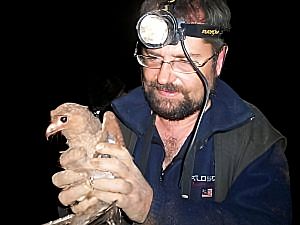Cueva de los Tayos facts for kids
Quick facts for kids Cueva de los Tayos |
|
|---|---|
| Cueva de los Tayos de Coangos | |

Cueva de los Tayos
|
|
| Location | Morona-Santiago Province |
| Length | 4.6 km (2.9 mi) |
| Elevation | 539 m (1,768 ft) |
| Discovery | Precolumbian era |
| Geology | Limestone & shale |
| Access | Restricted |
| Translation | Cave of the Oilbirds (Spanish) |
Cueva de los Tayos is a famous cave in Ecuador. Its name means "Cave of the Oilbirds" in Spanish. It is found on the eastern side of the Andes mountains in the Morona-Santiago province. This cave became very well-known after astronaut Neil Armstrong visited it in 1976. Sometimes, people call it Cueva de los Tayos de Coangos because the Río Coangos is nearby.
Contents
Exploring Cueva de los Tayos
Cueva de los Tayos is located deep within a rainforest. It is about 2 kilometers south of the Santiago River. The main entrance to the cave is a huge hole, like a giant shaft, that goes down 70 meters (about 230 feet). Local people have known about this cave for hundreds of years.
What the Cave Looks Like
The cave is about 539 meters (1,768 feet) above sea level. It is made of limestone and shale rock. The largest entrance is 65 meters (213 feet) deep. This leads to 4.6 kilometers (2.9 miles) of wide passages. There is even a huge chamber inside, measuring 90 by 240 meters (295 by 787 feet). The cave goes down 201 meters (659 feet) in total. Its lowest point ends in a water-filled passage called a sump. As of 2023, it is the longest cave in Ecuador.
The Shuar People and the Cave
The native Shuar people have a special connection to the cave. Each spring, they go into the cave to collect young oilbirds. These birds are called "guácharos" or "tayos" in Spanish. They use vine ladders and bamboo torches to help them. People have written about the cave since at least 1860. Gold-seekers and soldiers also visited it in the 1960s.
The cave is located on land belonging to the Sindical Center Coangos, which is a group of native people. The caves are not fully explored yet. The local Shuar Indians know a lot about the cave. They often guide cave explorers.
How to Visit the Cave
Access to Cueva de los Tayos is restricted. You need to get special permission and pay a fee. This fee helps the local communities. You can get permission in Sucúa, Ecuador, at the Shuar Center Federation (FICSH).
The Gold of the Gods Book
In 1973, a writer named Erich von Däniken wrote a book called The Gold of the Gods. In this book, he claimed that a person named János Juan Móricz had explored Cueva de los Tayos in 1969. Móricz supposedly found piles of gold, strange sculptures, and a "metallic library" inside. These items were said to be in tunnels built by a lost civilization. Von Däniken even suggested that extraterrestrial beings helped this ancient civilization. Many people believed that the cave might hold secrets from a lost civilization.
The 1976 Expedition
Because of the exciting claims in von Däniken's book, Stan Hall from Scotland organized a big expedition in 1976. This was one of the largest and most expensive cave explorations ever. More than a hundred people joined, including experts, military personnel from Britain and Ecuador, and a film crew. Even former American astronaut Neil Armstrong was part of the team!
What the Expedition Found
Eight experienced British cavers explored the cave very carefully. They made a detailed map of it. The expedition was paid for by the governments of Ecuador and the United Kingdom. The team did not find any of the gold or strange items von Däniken had described. However, they did find some natural features in the cave that matched his descriptions. They also found interesting plants, animals, and old archaeological items. The team discovered passages that looked neatly cut and polished deep inside the cave. They also found burial sites that were about 1500 years old.
The lead researcher met with Móricz's local source. This person claimed that the expedition had explored the wrong cave. They said the "real" cave was still a secret. Deep inside the cave, there are square-shaped rock cuttings and rock structures that look like long doors. This part is called the Moricz portal.
Later Expeditions (2006-2009)
Alex Chionetti, an explorer and filmmaker from Argentina, was a friend of the first explorers of the caves in the 1960s. He led several expeditions between 2006 and 2009. In 2007, he reached the deepest parts of the main cave, the Coangos River Cave. It took him many months of traveling through the jungle to get there.
New Discoveries
Chionetti found drawings of animals along the underground rivers in the Pastaza Tayos cave system. He also found an engraving on a gold-colored surface that looked like a double square. In Coangos, he was the first to record the "Moricz's Entrance Gate" digitally. He highlighted a special "cornerstone" there. This detail might show that parts of the cave were built or changed by people to fit the natural landscape.
Chionetti helped make the cave famous in 2010. He worked as a producer for the TV series 'Ancient Aliens' on the History Channel. In his book "Mysteries of the Tayos Caves," Chionetti shares his exciting and sometimes dangerous journey. He was even chased by a group of Shuar natives after leaving the caves. The American press wrote about his adventure, calling him a real-life Indiana Jones.
Expedition Unknown Episode (2018)
On January 31, 2018, Cueva de los Tayos was shown on the TV show Expedition Unknown. This episode was called "Hunt for the Metal Library." Explorer Josh Gates and his team went to Ecuador. They were helped by local Shuar people and Eileen Hall, who is the daughter of Stan Hall from the 1976 expedition. They explored the deep parts of the cave.
See also
 In Spanish: Cueva de los Tayos para niños
In Spanish: Cueva de los Tayos para niños


